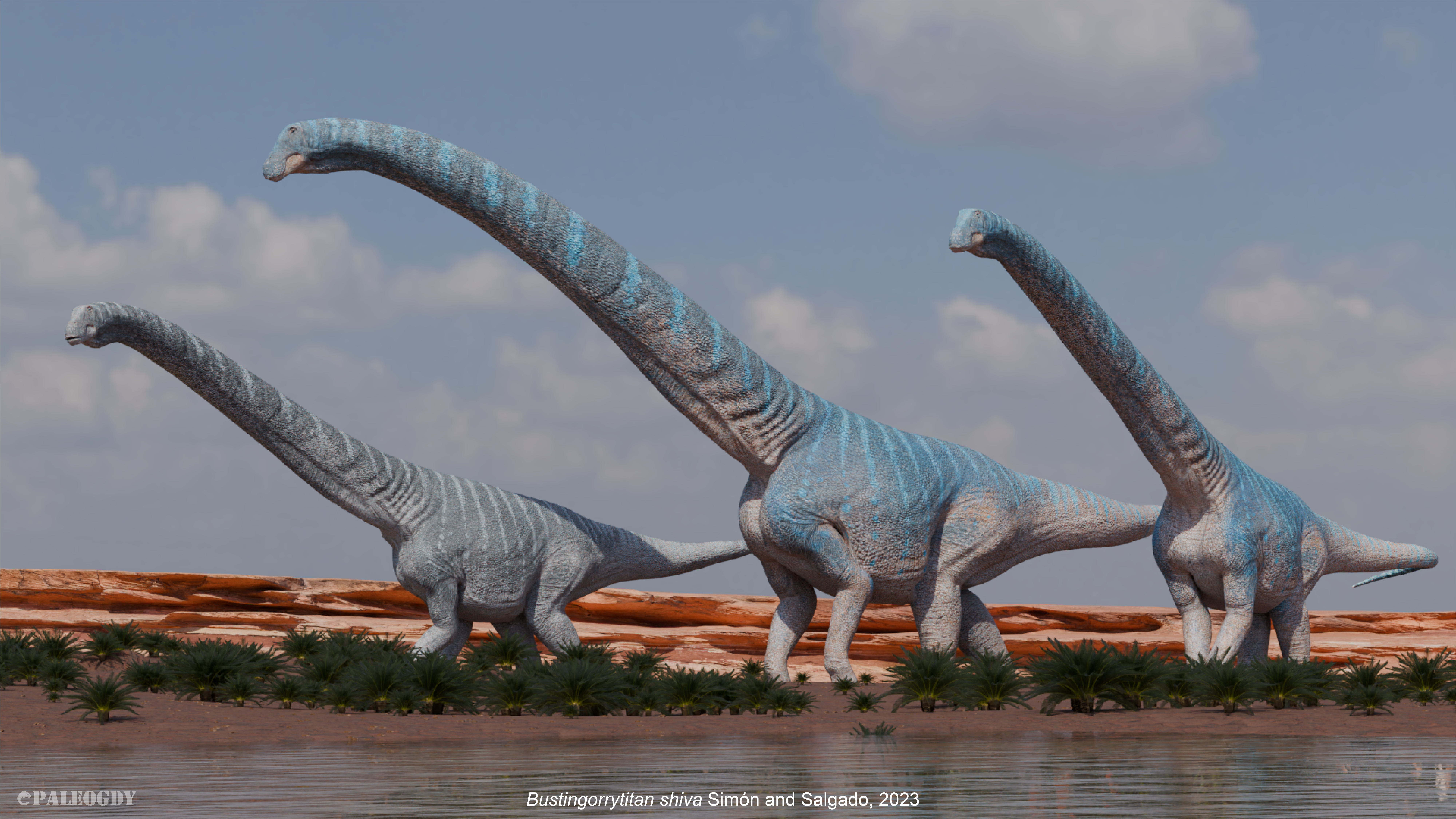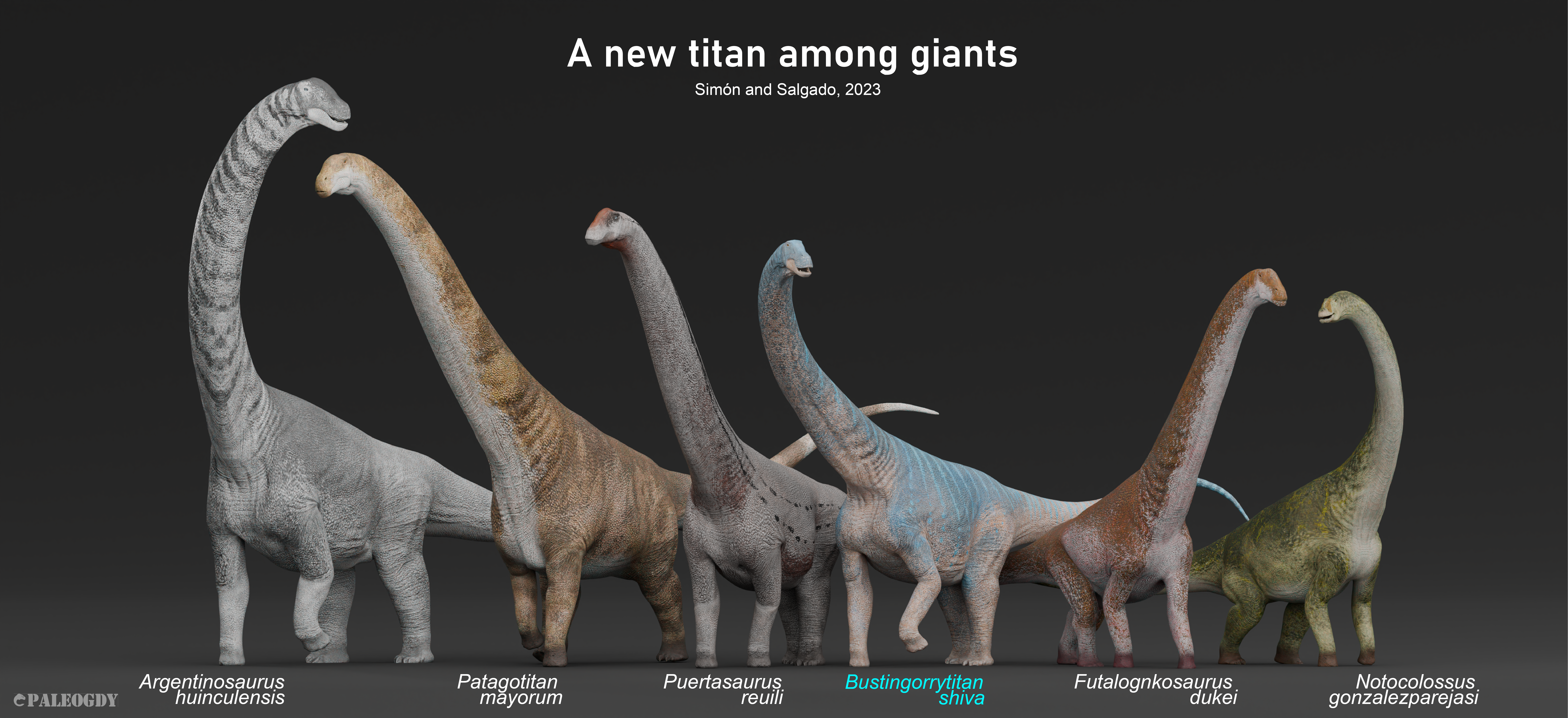Enormous dinosaur dubbed Shiva 'The Destroyer' is one of the biggest ever discovered
Researchers discovered the remains of a huge dinosaur named Bustingorrytitan shiva last year and have now released artistic reconstructions of the Cretaceous giant.

A newly discovered 98-foot-long dinosaur named after the Hindu god Shiva "The Destroyer" stomped around Argentina alongside other long-necked "megatitanosaurs" more than 90 million years ago, scientists reveal.
Researchers described the humongous beast, called Bustingorrytitan shiva, late last year from fossils discovered in western Argentina. Now, they've worked with an artist to recreate the Cretaceous titanosaur, a stockier type of long-necked sauropod, in stunning images and videos.
B. shiva is among the largest sauropods ever recorded, with an estimated weight of around 74 tons (67 metric tons), according to a study published Dec. 18, 2023, in the journal Acta Palaeontologica Polonica. It wasn't the largest dinosaur — fellow titanosaur Argentinosaurus is one contender for that disputed honor, with an estimated weight starting at 77 tons (70 metric tons) — but B. shiva was still an almighty member of the ancient Argentinian ecosystem.
The B. shiva discovery in the North Patagonia region of southern South America demonstrates that "megatitanosaurs" with gigantism in excess of 55 tons (50 metric tons) evolved separately within titanosaurs, according to study lead author María Edith Simón, a paleontologist who ran the B. shiva excavation.
"In Patagonia, we are still at a stage where we are more likely to find something new than something known, and the unknown is often wonderful," Simón told Live Science in an email. "In the publication we reported on a sauropod that became a giant, independently of others within their group."
Related: Gargantuan 'star lizard' was one of the last (and largest) dinosaurs of its kind
A farmer named Manuel Bustingorry found the first giant fossil from B. shiva on his land in Neuquén Province in 2000. Simón said she was responsible for the lab and research area at the nearby Ernesto Bachmann Paleontological Museum in the early 2000s and excavated the farm in 2001.
Sign up for the Live Science daily newsletter now
Get the world’s most fascinating discoveries delivered straight to your inbox.
"When we arrived at the site, it was really exciting," Simón said. "The bone was broken, but it looked like a tibia."
The exposed leg bone was just the beginning. Researchers found the remains of at least four individual dinosaurs belonging to the newfound species, including a relatively complete skeleton and three other incomplete specimens, according to the study.

B. shiva came from the 93 million to 96 million-year-old Huincul Formation of rocks, where Argentinosaurus was found. However, the bones had characteristics that don't match up with known sauropod species, including uniquely shaped crests on the humerus and femur.
The new research suggests that at least two lineages of gigantic titanosaurs — B. shiva's saltasauroids and Argentinosaurus' lognkosaurs — coexisted in North Patagonia in the middle of the Cretaceous period (145 million to 66 million years ago) alongside smaller sauropods, according to the study.
"Ecologically, each of the sauropods were distinct from one another, with different teeth, heads and bodies," Simón said. "This shows that they were all able to find a form where they could live without competing with one another."
B. shiva's genus name, "Bustingorrytitan," combines the last name of farmer Manuel Bustingorry with "titan," after the giants from Greek mythology. It lived during a period of extinction and new life, so Simón said the team chose the species name "shiva" to reference the supreme deity of Shaivism, who destroys and transforms the universe.
A turnover event in the middle of the Cretaceous saw the extinction of species such as early diplodocoid sauropods and certain titanosaurs, according to the study. Researchers still have much to learn about what happened to B. shiva, but the study authors noted that some of its saltasauroid lineage survived the turnover and lived on until near the end of the Cretaceous, when the asteroid struck and wiped out non-avian dinosaurs for good.

Patrick Pester is the trending news writer at Live Science. His work has appeared on other science websites, such as BBC Science Focus and Scientific American. Patrick retrained as a journalist after spending his early career working in zoos and wildlife conservation. He was awarded the Master's Excellence Scholarship to study at Cardiff University where he completed a master's degree in international journalism. He also has a second master's degree in biodiversity, evolution and conservation in action from Middlesex University London. When he isn't writing news, Patrick investigates the sale of human remains.










